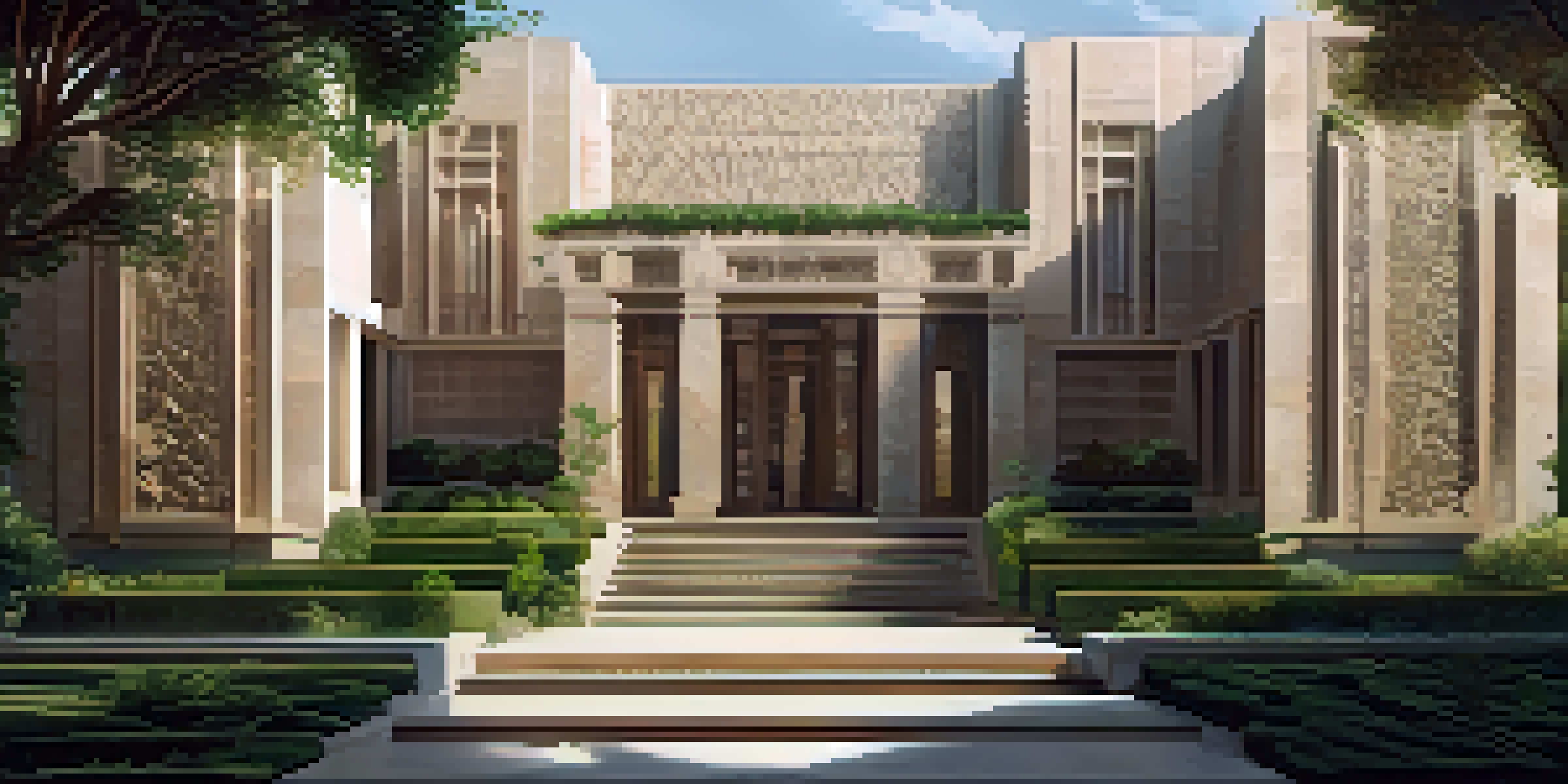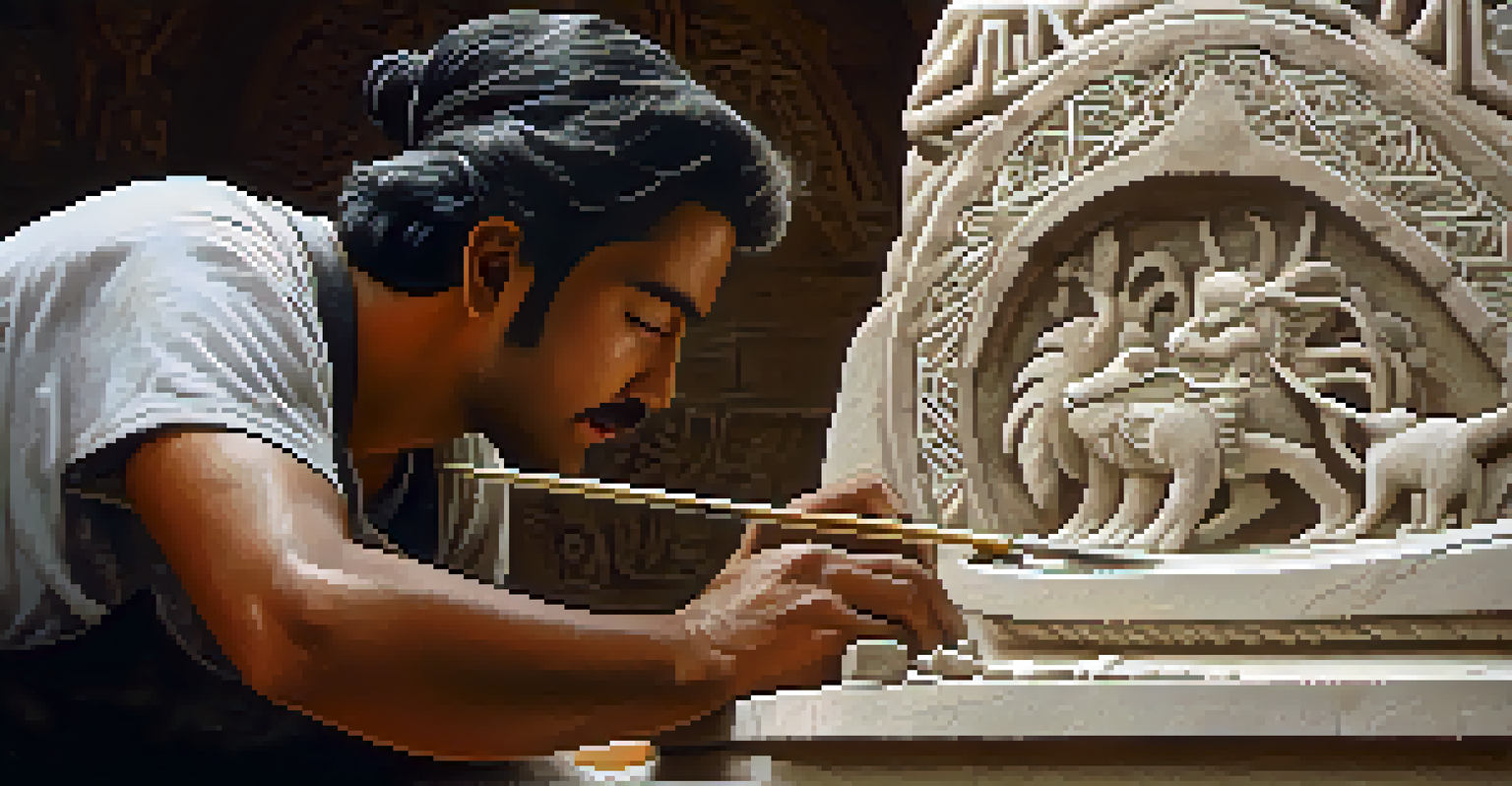Carved Stone: A Timeless Element in Contemporary Architecture

Understanding Carved Stone in Modern Architecture
Carved stone has been a beloved material throughout history, and its relevance continues in contemporary architecture. This unique medium brings a sense of permanence and artistry that few other materials can match. Architects today embrace carved stone for its ability to blend traditional craftsmanship with modern design aesthetics.
Architecture is the learned game, correct and magnificent, of forms assembled in the light.
The beauty of carved stone lies not only in its texture and color but also in the stories it tells. Each piece can reflect local culture and history, making buildings feel rooted in their surroundings. This connection to the past is increasingly important in a fast-paced world where people seek authenticity and meaning.
Moreover, the versatility of carved stone allows it to fit seamlessly into various architectural styles, from sleek modernist designs to rustic structures. As architects experiment with forms and finishes, carved stone remains a reliable choice, embodying both elegance and strength.
The Aesthetic Appeal of Carved Stone
The aesthetic charm of carved stone is undeniable, transforming ordinary structures into stunning works of art. The intricate patterns and designs can evoke emotions, drawing people in and creating memorable experiences. Just think of cathedrals where stone carvings tell biblical stories or public buildings adorned with detailed friezes that celebrate local heritage.

In contemporary architecture, this material allows designers to play with light and shadow, adding depth to facades and interiors. For instance, a building with a rough-hewn stone exterior can appear dynamic and alive as sunlight shifts throughout the day. This interplay elevates the overall design, creating a visual feast that captivates onlookers.
Carved Stone: A Timeless Material
Carved stone blends traditional craftsmanship with modern design, offering both beauty and durability in architecture.
Carved stone also brings a natural element to urban environments, helping to soften the hard lines of contemporary architecture. By incorporating organic textures and colors, architects create a harmonious balance between the built environment and nature, making spaces feel more inviting.
Sustainability and Carved Stone Usage
Sustainability is a hot topic in architecture today, and carved stone stands out as an eco-friendly material choice. Sourced from quarries, it is a natural resource that, when responsibly managed, can be harvested without depleting the earth. Furthermore, stone's durability means that buildings can last for generations, reducing the need for frequent renovations or replacements.
The best buildings become a part of the landscape and enhance the environment around them.
Additionally, many stone quarries are now adopting sustainable practices, such as minimizing waste and restoring landscapes post-extraction. This conscientious approach not only preserves the environment but also contributes to the longevity and appeal of carved stone. Architects who prioritize sustainability can feel confident in their choice of material.
Using carved stone in design can also enhance a building's energy efficiency. Its thermal mass helps regulate indoor temperatures, reducing reliance on heating and cooling systems. This energy-saving characteristic aligns with the goals of modern architecture, which aims to create eco-friendly and cost-effective structures.
Cultural Significance of Carved Stone
Carved stone carries rich cultural significance, often reflecting the identity of a community or region. Throughout history, different cultures have used this material to express their artistic values and beliefs, from ancient temples to modern public spaces. By incorporating carved stone into contemporary architecture, designers pay homage to these traditions while creating spaces that resonate with today's society.
For example, many cities are now commissioning local artists to create unique stone carvings for public buildings. These artworks not only beautify the space but also foster a sense of community pride and connection. When people see familiar motifs or stories represented in stone, it strengthens their bond with the environment.
Sustainability in Stone Usage
This eco-friendly material promotes sustainability through responsible sourcing and long-lasting durability, reducing renovation needs.
Using carved stone also encourages the preservation of traditional craftsmanship skills. As architects and builders collaborate with skilled artisans, they help sustain these practices and keep cultural narratives alive. This results in a richer architectural landscape that honors the past while embracing innovation.
Innovative Techniques in Carving Stone
Advancements in technology have revolutionized the way stone is carved, allowing for innovative designs that were previously unimaginable. Computer-aided design (CAD) software and CNC (computer numerical control) machines enable precise and intricate carvings that enhance the beauty of this timeless material. This fusion of technology with traditional techniques results in stunning architectural features that capture attention.
For example, architects can now create complex geometric patterns or custom designs that cater to specific project themes. This ability to personalize stonework makes it an appealing choice for clients looking to add a unique touch to their buildings. The result is a harmonious blend of craftsmanship and modernity that defines contemporary architecture.
Moreover, these innovative methods streamline the production process, making it more efficient and cost-effective. By reducing waste and labor time, architects can incorporate carved stone into their projects without breaking the budget. This accessibility encourages more designers to explore the possibilities of this timeless material.
Carved Stone in Landscape Architecture
Carved stone isn't just for buildings; it also plays a vital role in landscape architecture. From pathways and retaining walls to decorative sculptures, stone adds elegance and functionality to outdoor spaces. The natural beauty of carved stone complements gardens, parks, and public plazas, creating inviting environments for people to enjoy.
Incorporating carved stone elements into landscapes can enhance the overall aesthetic and provide a sense of unity with the surrounding architecture. For instance, a building with a stone facade can be paired with stone benches or walkways to create a cohesive design. This thoughtful integration fosters a harmonious relationship between indoor and outdoor spaces.
Cultural Heritage Through Design
Incorporating carved stone into architecture reflects local culture and traditions, fostering community pride and preserving craftsmanship.
Additionally, carved stone features can serve practical purposes, such as erosion control or drainage management. By utilizing this durable material, landscape architects can design spaces that are not only beautiful but also sustainable and resilient. This approach helps ensure that outdoor areas remain vibrant and functional for years to come.
The Future of Carved Stone in Architecture
As we look to the future, the role of carved stone in architecture appears promising. With an increasing emphasis on sustainability and cultural relevance, this timeless material is poised to remain a staple in modern design. Architects are continuously reimagining carved stone's potential, pushing boundaries while respecting its rich history.
Moreover, the trend towards biophilic design—creating spaces that connect people with nature—aligns perfectly with the use of carved stone. Its organic textures and forms can evoke the natural world, fostering a sense of well-being and tranquility in urban environments. As cities evolve, incorporating elements like carved stone can enhance the quality of life for residents.

In conclusion, carved stone is more than just a building material; it is a bridge between the past and the future. As architects explore the endless possibilities of this medium, we can expect to see innovative designs that honor tradition while embracing modernity. The enduring charm of carved stone will undoubtedly continue to inspire generations to come.